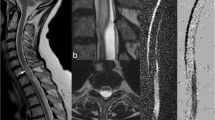Abstract
Introduction
Lhermitte-Duclos disease (LDD, dysplastic gangliocytoma) is an extremely rare cerebellar lesion of uncertain etiology. The debate as to whether it constitutes a neoplastic, malformative, or hamartomatous lesion is still continuing. In this report we explore the usefulness of susceptibility-weighted imaging (SWI), diffusion weighted imaging (DWI), perfusion imaging, and chemical shift imaging (CSI) in demonstrating the pathology and pathophysiology in two patients with LDD.
Methods
MR imaging of the brain and the cervicodorsal spine was performed on a 1.5-T scanner in a 47-year-old woman presenting with numbness and paresthesia of both upper and lower limbs, and in a 17-year-old male with right frontal headache associated with neck pain.
Results
Routine imaging in the first patient showed a left-side cerebellar mass with characteristic ’tiger-striped’ thick folia associated with Chiari I malformation, tonsillar herniation and cervicodorsal syringomyelia and in the second patient a right cerebellar mass with similar findings. The SWI demonstrated the characteristic deep running veins between the folia, which is thought to be the cause for vascular contrast enhancement. Diffusion showed a T2 shine-through effect with mild increased diffusivity, and perfusion showed increase in relative cerebral blood volume, relative cerebral blood flow, and mean transit time in the lesion. MR spectroscopy demonstrated reduction in metabolites and a prominent lactate peak in both the patients. The pathological and pathophysiological significance of these findings is discussed.
Conclusion
MRI with the newer imaging capabilities can demonstrate the pathology and pathophysiology in Lhermitte-Duclos disease better. SWI helps in detecting the veins around the thickened folia.




Similar content being viewed by others
References
Williams DW 3rd, Elster AD, Ginsberg LE, Stanton C (1992) Recurrent Lhermitte-Duclos disease: report of two cases and association with Cowden’s disease. AJNR Am J Neuroradiol 13:287–290
Nowak DA, Trost HA (2002) Lhermitte-Duclos disease (dysplastic cerebellar gangliocytoma): a malformation, hamartoma or neoplasm? Acta Neurol Scand 105:137–145
Demaerel P, Van Calenbergh F, Wilms G (2003) Lhermitte-Duclos disease: a tumour or not a tumour. Acta Neurol Scand 108:294–295
Kulkantrakorn K, Awwad EE, Levy B, Selhorst JB, Cole HO, Leake D, Gussler JR, Epstein AD, Malik MM (1997) MRI in Lhermitte-Duclos disease. Neurology 48:725–731
Klisch J, Juengling F, Spreer J, Koch D, Thiel T, Buchert M, Arnold S, Feuerhake F, Schumacher M (2001) Lhermitte-Duclos disease: assessment with MR imaging, positron emission tomography, single-photon emission CT, and MR spectroscopy. AJNR Am J Neuroradiol 22:824–830
Lhermitte J, Duclos P (1920) Sur un ganglioneurome diffus du cortex du cervelet. Bull Assoc Fr Etude Cancer 9:99–107
Robinson S, Cohen AR (2006) Cowden disease and Lhermitte-Duclos disease: an update. Case report and review of the literature. Neurosurg Focus 20:E6
Van Calenbergh F, Vantomme N, Flamen P, Demaerel P, Sciot R, Legius E, Mortelmans L, Plets C (2006) Lhermitte-Duclos disease: 11C-methionine positron emission tomography data in 4 patients. Surg Neurol 65:293–296
Carlson JJ, Milburn JM, Barre GM (2006) Lhermitte-Duclos disease: case report. J Neuroimaging 16:157–162
Marcus CD, Galeon M, Peruzzi P, Bazin A, Bernard MH, Pluot M, Menanteau B (1996) Lhermitte-Duclos disease associated with syringomyelia. Neuroradiology 38:529–531
Wolansky LJ, Malantic GP, Heary R, Maniker AH, Lee HJ, Sharer LR, Patel UJ (1996) Preoperative MRI diagnosis of Lhermitte-Duclos disease: case report with associated enlarged vessel and syrinx. Surg Neurol 45:470–475
Sehgal V, Delproposto Z, Haddar D, Haacke EM, Sloan AE, Zamorano LJ, Barger G, Hu J, Xu Y, Prabhakaran KP, Elangovan IR, Neelavalli J, Reichenbach JR (2006) Susceptibility-weighted imaging to visualize blood products and improve tumor contrast in the study of brain masses. J Magn Reson Imaging 24:41–51
Sehgal V, Delproposto Z, Haacke EM, Tong KA, Wycliffe N, Kido DK, Xu Y, Neelavalli J, Haddar D, Reichenbach JR (2005) Clinical applications of neuroimaging with susceptibility-weighted imaging. J Magn Reson Imaging 22:439–450
Awwad EE, Levy E, Martin DS, Merenda GO (1995) Atypical MR appearance of Lhermitte-Duclos disease with contrast enhancement. AJNR Am J Neuroradiol 16:1719–1720
Spaargaren L, Cras P, Bomhof MA, Lie ST, de Barsy AM, Croese PH, Teepen JL, Duwel VH, Van Goethem JW, Ozsarlak O, van den Hauwe L, De Schepper AM, Parizel PM (2003) Contrast enhancement in Lhermitte-Duclos disease of the cerebellum: correlation of imaging with neuropathology in two cases. Neuroradiology 45:381–385
Moonis G, Ibrahim M, Melhem ER (2004) Diffusion-weighted MRI in Lhermitte-Duclos disease: report of two cases. Neuroradiology 46:351–354
Gaballo A, Palma M, Dicuonzo F, Carella A (2005) Lhermitte-Duclos disease: MR diffusion and spectroscopy. Radiol Med (Torino) 110:378–384
Ogasawara K, Beppu T, Yasuda S, Kobayashi M, Yukawa H, Ogawa A (2001) Blood flow and oxygen metabolism in a case of Lhermitte-Duclos disease: results of positron emission tomography. J Neurooncol 55:59–61
Ogasawara K, Yasuda S, Beppu T, Kobayashi M, Doi M, Kuroda K, Ogawa A (2001) Brain PET and technetium-99m-ECD SPECT imaging in Lhermitte-Duclos disease. Neuroradiology 43:993–996
Moller-Hartmann W, Herminghaus S, Krings T, Marquardt G, Lanfermann H, Pilatus U, Zanella FE (2002) Clinical application of proton magnetic resonance spectroscopy in the diagnosis of intracranial mass lesions. Neuroradiology 44:371–381
Nagaraja S, Powell T, Griffiths PD, Wilkinson ID (2004) MR imaging and spectroscopy in Lhermitte-Duclos disease. Neuroradiology 46:355–358
Acknowledgement
The authors wish to thank Siemens Medical Systems for providing the SWI sequence and postprocessing tools.
Conflict of interest statement
We declare that we have no conflict of interest.
Author information
Authors and Affiliations
Corresponding author
Rights and permissions
About this article
Cite this article
Thomas, B., Krishnamoorthy, T., Radhakrishnan, V.V. et al. Advanced MR imaging in Lhermitte-Duclos disease: moving closer to pathology and pathophysiology. Neuroradiology 49, 733–738 (2007). https://doi.org/10.1007/s00234-007-0241-1
Received:
Accepted:
Published:
Issue Date:
DOI: https://doi.org/10.1007/s00234-007-0241-1




